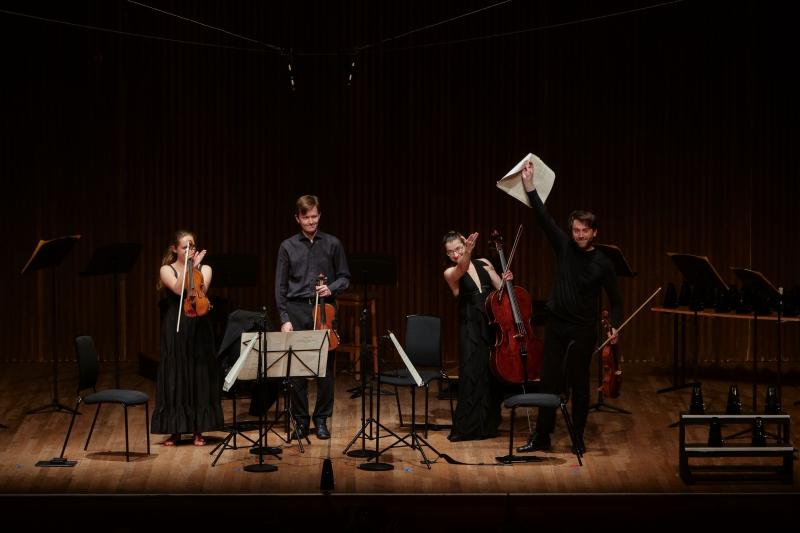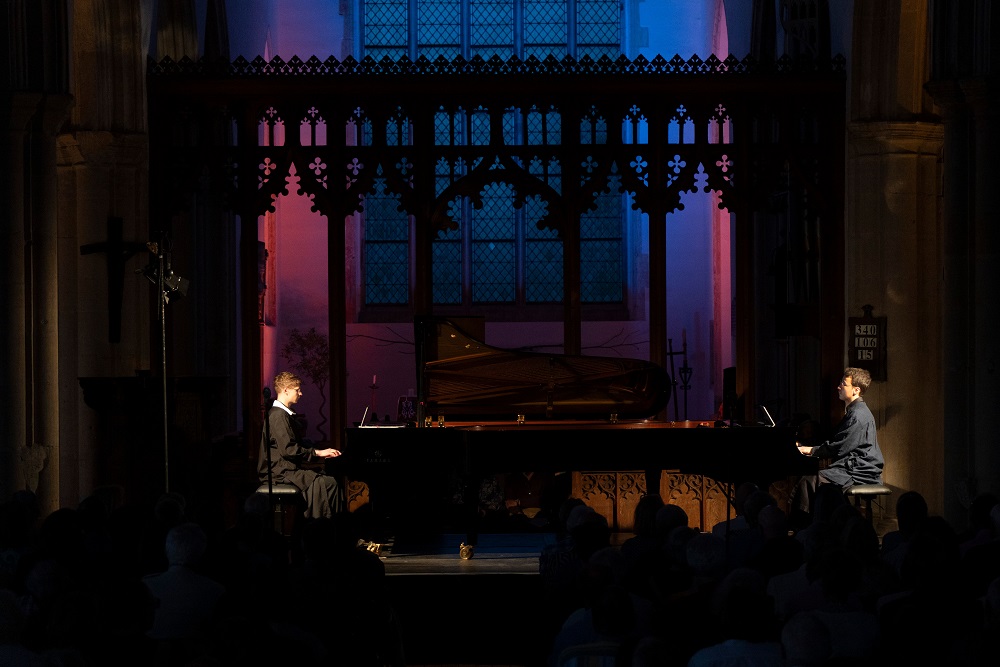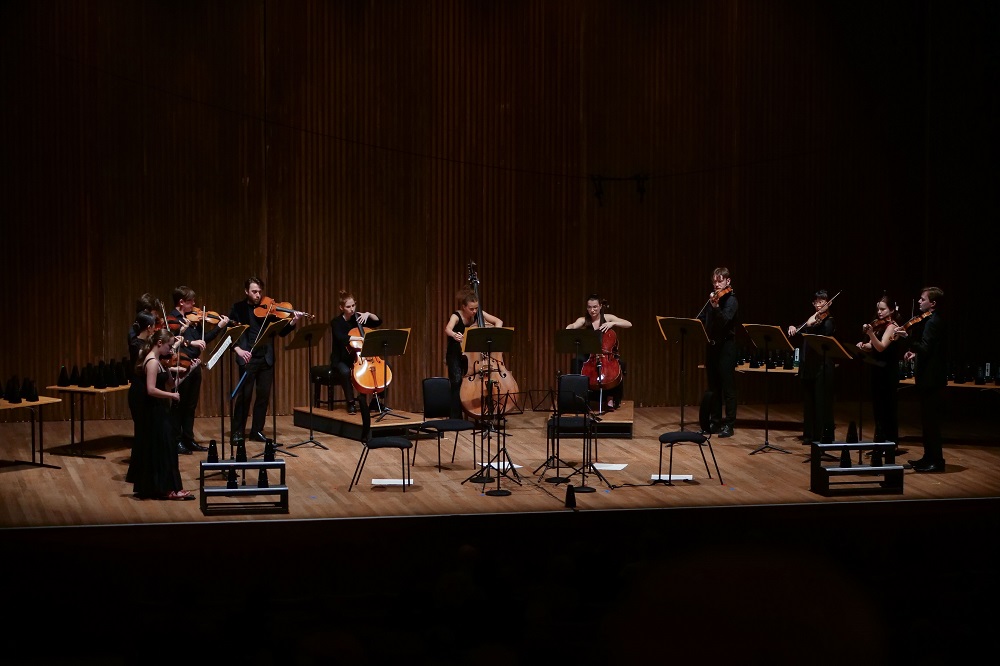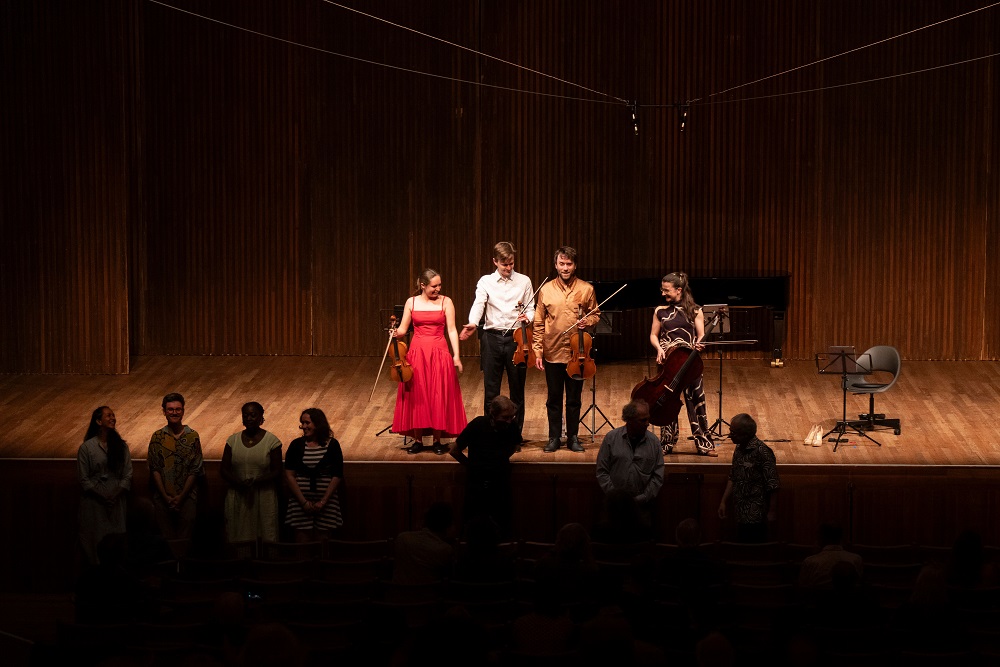Ligeti Day; Kolesnikov/Tsoy, Aldeburgh Festival review - 14 musicians, 16 premieres and 100 metronomes | reviews, news & interviews
Ligeti Day; Kolesnikov/Tsoy, Aldeburgh Festival review - 14 musicians, 16 premieres and 100 metronomes
Ligeti Day; Kolesnikov/Tsoy, Aldeburgh Festival review - 14 musicians, 16 premieres and 100 metronomes
More boundaries dissolved in Snape and Blythburgh

To give the first performance of a dazzling fantasia in the context of a rangy sunny-evening-to-night concert, as pianists Pavel Kolesnikov and Samson Tsoy did in glorious Blythburgh Church, merits a gold medal in piano-duo enterprise. To premiere 15 new works in a single programme and adapt perfectly to the various styles, the Ligeti Quartet’s crowning glory of three events celebrating their namesake’s centenary, is simply superhuman.
"That must have been very atmospheric." commented a fellow audience member at the Ligeti experience who'd not been able to get to the Kolesnikov/Tsoy special (I'd been equally ruefull not to have been free for the Britten Pears Contemporary Ensemble event earlier that Thursday). It was: to go from sunlight flooding through the clerestory windows at 8.30pm to blue lighting of the chancel, darkness beyond, and emerging to see the moon and Venus so clearly several hours later is something I'll never forget. But this was also a profoundly rich and layered programme.  Both pianists like to provide surprising juxtapositions, in this case with Schubert and Desyatnikov at the core. Seated opposite each other at the two Yamaha pianos, they began with alternating Schubert movements, Kolesnikov in the relatively early C sharp minor Menuet with Bachian tread followed by Tsoy totally poised in the same key for the most beautifully resolved of all slow movements, the Andante sostenuto from the final sonata D960, and then a string of miniature waltz-gems rounded off by the more substantial, but still sunny, A flat Impromptu (D935 No. 2). Those served as a necessary intermezzo before the premiere, the Kharkiv-born composer's Trompe-l'oeil. I deliberately didn't read the note before listening, and it came across as a crazy confection of what felt like 150 or so dances with the occasional Bartók twang.
Both pianists like to provide surprising juxtapositions, in this case with Schubert and Desyatnikov at the core. Seated opposite each other at the two Yamaha pianos, they began with alternating Schubert movements, Kolesnikov in the relatively early C sharp minor Menuet with Bachian tread followed by Tsoy totally poised in the same key for the most beautifully resolved of all slow movements, the Andante sostenuto from the final sonata D960, and then a string of miniature waltz-gems rounded off by the more substantial, but still sunny, A flat Impromptu (D935 No. 2). Those served as a necessary intermezzo before the premiere, the Kharkiv-born composer's Trompe-l'oeil. I deliberately didn't read the note before listening, and it came across as a crazy confection of what felt like 150 or so dances with the occasional Bartók twang.
In fact, the glimmers of familiarity belonged less obviously to reworked sequences from the Schubert F minor Fantaisie which was to end the evening, though not the sad connecting theme. How well it hangs together I'm not sure, and not having checked how long it was due to last, I found it a bit overstuffed. But the phenomenal rhythmic fun and games were handled with breathtaking clarity by the two pianists at one of the instruments. Desyatnikov's Du côté de Chez Swan [sic - "The Swan" was the title of the event; Kolesnikov saw Blythburgh Church above the estuary as similarly "tall and icy", both building and bird as beauties hiding "more bruising characteristics", and what eventual emerges after all the opening honking here is the accompaniment of Saint-Saëns' Carnival glider]. Familiar to anyone who attended the duo's LSO St Luke's recital last year, this ever-surprising paraphrase-plus felt completely different at the heart of the Blythburgh second half.  We had further mesmerising shimmers in Morton Feldman's Work for Two PIanists, a hallucinatory invitation to nightfall, and the Barcarolle from Rachmaninov's First Suite (another movement, "Larmes", the encore in the duo's recent Queen Elizabeth Hall recital, is more original, but perhaps this fitted better with the other water-music). I've lost count of how many times I've heard Kolesnikov and Tsoy play the Schubert Fantaisie, but it does seem to go deeper on each reacquaintance, and sounded so well in the angel-roofed, now blue-lit church. A suitable end to an epic adventure.
We had further mesmerising shimmers in Morton Feldman's Work for Two PIanists, a hallucinatory invitation to nightfall, and the Barcarolle from Rachmaninov's First Suite (another movement, "Larmes", the encore in the duo's recent Queen Elizabeth Hall recital, is more original, but perhaps this fitted better with the other water-music). I've lost count of how many times I've heard Kolesnikov and Tsoy play the Schubert Fantaisie, but it does seem to go deeper on each reacquaintance, and sounded so well in the angel-roofed, now blue-lit church. A suitable end to an epic adventure.
The next one began at 3pm in Snape Maltings Concert Hall - a big space for what was mostly a fearless string quartet working its way through al Ligeti's chamber and instrumental music for strings before the parade of commissions paying homage to his piano Etudes (played earlier in the festival by the peerless Pierre-Laurent Aimard). The sit-where-you-like audience was sizeable for the second of the three events (possibly the promise of 100 metronomes and two kosher string quartets did it). There's enough contrast in Ligeti works early, middle and late to make it work, though two of the solo contributions from Ligeti Quartet members were disconcerting: without the scores, I couldn't tell if Ligeti's injunctions in his Cello and Viola Sonatas were asking for "bent" pitches rather than the occasional intonational problems we seemed to be getting here, or just really awkwardly written.
At least first violinist Freya Goldmark's all-out assault on the cadenza John Zorn wrote for the Violin Concerto proved hair-raising in the right sense, and her opening teamwork with colleague Patrick Dawkins gave us the folk-balm we needed in the Baladă și joc of 1950. The hour ended with even more inward charm than it began: the Andante and Allegro for string quartet of the same year een sounds like Tippett pastoral.  Visuals had been well set up for different groupings in different pools of light during that opener, and the empty stage looked suitably dramatic at the start of the 5pm event, the 100 metronomes required for the (in)famous Poème Symphonique of 1962 symmetrically grouped on various tables, to be operated by the Ligetis with seven students from the Royal Academy of Music. The result is a bit anticlimactic: what you get is mostly a sound like heavy rain on a tin roof or polite applause, until the metronomic "voices" drop out one by one. At least the segue in to Ramifications for 12 strings was beautifully stage-managed, all metronome operators picking up their instruments and grouping in more perfect symmetry (pictured below).
Visuals had been well set up for different groupings in different pools of light during that opener, and the empty stage looked suitably dramatic at the start of the 5pm event, the 100 metronomes required for the (in)famous Poème Symphonique of 1962 symmetrically grouped on various tables, to be operated by the Ligetis with seven students from the Royal Academy of Music. The result is a bit anticlimactic: what you get is mostly a sound like heavy rain on a tin roof or polite applause, until the metronomic "voices" drop out one by one. At least the segue in to Ramifications for 12 strings was beautifully stage-managed, all metronome operators picking up their instruments and grouping in more perfect symmetry (pictured below).
This was surely the masterpiece in all the Ligeti works we heard, perfectly embodying the "uncertain" harmonies which the composer describes as high-smelling and beginning to decompose. The elements are there, or incipient, in the two string quartets, but the thread that binds the dance-variations of Metamorphoses nocturnes is fragile, and the contrasts of the Second Quartet's five movements, from mystery to violence and back, don't quite cohere. Maybe that's part of the point, but oddly son Lukas's Entasis, first of the 8pm concert's premieres, tends more to the "take care of the sounds and the sense will take care of itself" line in quartet music, a marvellousy organic work.  The rest came under the umbrella of the Nouvelles Etudes titles, paying a compliment to Ligeti's Nouvelles Aventures in 14 colours of the rainbow from contemporary composers. And what adventures. The Ligeti Quartet grouped them in two groups of four pieces and two of three, Since the order was quite different from the alphabetical parade in the programme, their inventors' names weren't always clearly caught despite announcements from the quartet members, and it would have been good to have them all up on stage and named at the end (unhelpfully, too, the programme doesn't have biographies or photographs). Rolf Hind kicked off, requiring a Ligeti-Etudesque flourish from a very briefly present piano - Freya Goldmark's brother making an uncredired appearance - before running quite a gamut in a very short space of time, up to seraphic whistles at the end.
The rest came under the umbrella of the Nouvelles Etudes titles, paying a compliment to Ligeti's Nouvelles Aventures in 14 colours of the rainbow from contemporary composers. And what adventures. The Ligeti Quartet grouped them in two groups of four pieces and two of three, Since the order was quite different from the alphabetical parade in the programme, their inventors' names weren't always clearly caught despite announcements from the quartet members, and it would have been good to have them all up on stage and named at the end (unhelpfully, too, the programme doesn't have biographies or photographs). Rolf Hind kicked off, requiring a Ligeti-Etudesque flourish from a very briefly present piano - Freya Goldmark's brother making an uncredired appearance - before running quite a gamut in a very short space of time, up to seraphic whistles at the end.
Homages to Ligeti's sense of concert theatre were exuberantly served, with the Ligeti Quartet also required to sing, stamp and move about the stage: vibrancy here from Nicole Lizée's Entreflaques, and a dramatic staging for the grand finale, Ligeti pupil Silvia Fômina's Vertigo: the unsupportable pleasure. Expected fury and willdness from Mandhira de Saram (Chers Amis) and Ana Sokolović's rhythmically brilliant Ungharese: Ghost 3 flanked introspective poetry frin Sidney Corbett, working entirely with the notes of Etude No 11 in Suspended Disbelief. More dazzle came from Emily Hazrati in György's Apprenice, viola initiating a thicket of notes taken up by the other players, and a haunting mix of microtones and melody in Manfted Stahnke's 9th String Quartet: Fragment..  I realise I haven't mentioned every "Nouvelle Etude", but I'd be happy to hear each one again. The players had a golden key to the multitudinous styles of this savage parade: you knew each work had fullest value and meticulous preparation. BBC Radio 3 will broadcast the concert, but here's an even more intriguing idea, which Hind - a fine interpreter of the originals - very much liked the sound of: a proper two-part evening with each piano Etude followed by its homage. The idea should run and run; this is only the beginning. Ligeti would have loved every second.
I realise I haven't mentioned every "Nouvelle Etude", but I'd be happy to hear each one again. The players had a golden key to the multitudinous styles of this savage parade: you knew each work had fullest value and meticulous preparation. BBC Radio 3 will broadcast the concert, but here's an even more intriguing idea, which Hind - a fine interpreter of the originals - very much liked the sound of: a proper two-part evening with each piano Etude followed by its homage. The idea should run and run; this is only the beginning. Ligeti would have loved every second.
The future of Arts Journalism
You can stop theartsdesk.com closing!
We urgently need financing to survive. Our fundraising drive has thus far raised £49,000 but we need to reach £100,000 or we will be forced to close. Please contribute here: https://gofund.me/c3f6033d
And if you can forward this information to anyone who might assist, we’d be grateful.

Subscribe to theartsdesk.com
Thank you for continuing to read our work on theartsdesk.com. For unlimited access to every article in its entirety, including our archive of more than 15,000 pieces, we're asking for £5 per month or £40 per year. We feel it's a very good deal, and hope you do too.
To take a subscription now simply click here.
And if you're looking for that extra gift for a friend or family member, why not treat them to a theartsdesk.com gift subscription?
more Classical music
 From Historical to Hip-Hop, Classically Black Music Festival, Kings Place review - a cluster of impressive stars for the future
From quasi-Mozartian elegance to the gritty humour of a kitchen inspection
From Historical to Hip-Hop, Classically Black Music Festival, Kings Place review - a cluster of impressive stars for the future
From quasi-Mozartian elegance to the gritty humour of a kitchen inspection
 Shibe, LSO, Adès, Barbican review - gaudy and glorious new music alongside serene Sibelius
Adès’s passion makes persuasive case for the music he loves, both new and old
Shibe, LSO, Adès, Barbican review - gaudy and glorious new music alongside serene Sibelius
Adès’s passion makes persuasive case for the music he loves, both new and old
 Anja Mittermüller, Richard Fu, Wigmore Hall review - a glorious hall debut
The Austrian mezzo shines - at the age of 22
Anja Mittermüller, Richard Fu, Wigmore Hall review - a glorious hall debut
The Austrian mezzo shines - at the age of 22
 First Person: clarinettist Oliver Pashley on the new horizons of The Hermes Experiment's latest album
Compositions by members of this unusual quartet feature for the first time
First Person: clarinettist Oliver Pashley on the new horizons of The Hermes Experiment's latest album
Compositions by members of this unusual quartet feature for the first time
 Gesualdo Passione, Les Arts Florissants, Amala Dior Company, Barbican review - inspired collaboration excavates the music's humanity
At times it was like watching an anarchic religious procession
Gesualdo Passione, Les Arts Florissants, Amala Dior Company, Barbican review - inspired collaboration excavates the music's humanity
At times it was like watching an anarchic religious procession
 Classical CDs: Camels, concrete and cabaret
An influential American composer's 90th birthday box, plus British piano concertos and a father-and-son duo
Classical CDs: Camels, concrete and cabaret
An influential American composer's 90th birthday box, plus British piano concertos and a father-and-son duo
 Cockerham, Manchester Camerata, Sheen, Martin Harris Centre, Manchester review - re-enacting the dawn of modernism
Two UK premieres added to three miniatures from a seminal event of January 1914
Cockerham, Manchester Camerata, Sheen, Martin Harris Centre, Manchester review - re-enacting the dawn of modernism
Two UK premieres added to three miniatures from a seminal event of January 1914
 Kempf, Brno Philharmonic, Davies, Bridgewater Hall, Manchester review - European tradition meets American jazz
Bouncing Czechs enjoy their Gershwin and Brubeck alongside Janáček and Dvořák
Kempf, Brno Philharmonic, Davies, Bridgewater Hall, Manchester review - European tradition meets American jazz
Bouncing Czechs enjoy their Gershwin and Brubeck alongside Janáček and Dvořák
 Solomon, OAE, Butt, QEH review - daft Biblical whitewashing with great choruses
Even a top soprano and mezzo can’t make this Handel paean wholly convincing
Solomon, OAE, Butt, QEH review - daft Biblical whitewashing with great choruses
Even a top soprano and mezzo can’t make this Handel paean wholly convincing
 Two-Piano Gala, Kings Place review - shining constellations
London Piano Festival curators and illustrious friends entertain and enlighten
Two-Piano Gala, Kings Place review - shining constellations
London Piano Festival curators and illustrious friends entertain and enlighten
 Echo Vocal Ensemble, Latto, Union Chapel review - eclectic choral programme garlanded with dance
Beautiful singing at the heart of an imaginative and stylistically varied concert
Echo Vocal Ensemble, Latto, Union Chapel review - eclectic choral programme garlanded with dance
Beautiful singing at the heart of an imaginative and stylistically varied concert
 Scott, Irish Baroque Orchestra, Whelan, RIAM, Dublin review - towards a Mozart masterpiece
Characteristic joy and enlightenment from this team, but a valveless horn brings problems
Scott, Irish Baroque Orchestra, Whelan, RIAM, Dublin review - towards a Mozart masterpiece
Characteristic joy and enlightenment from this team, but a valveless horn brings problems

Add comment